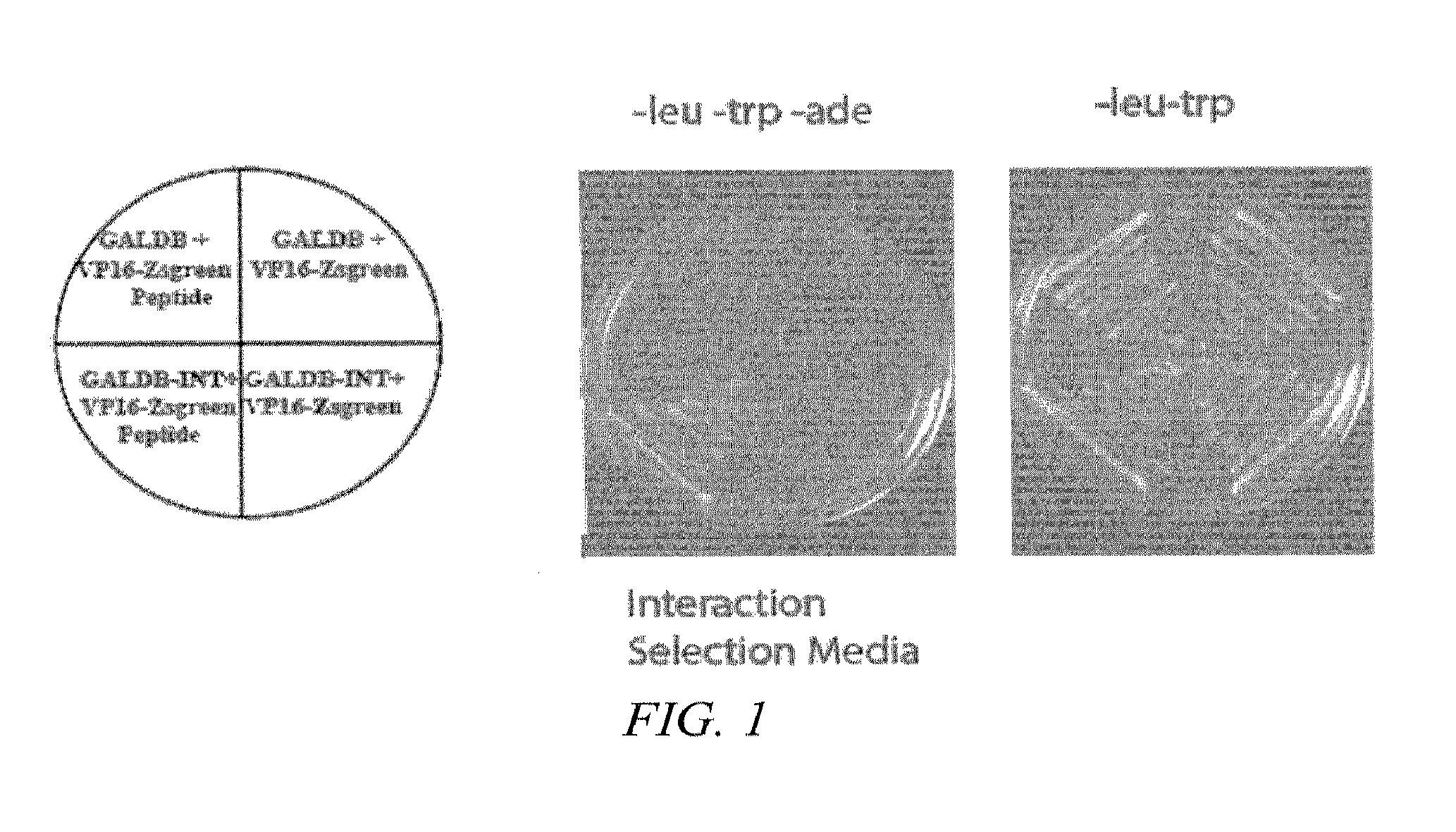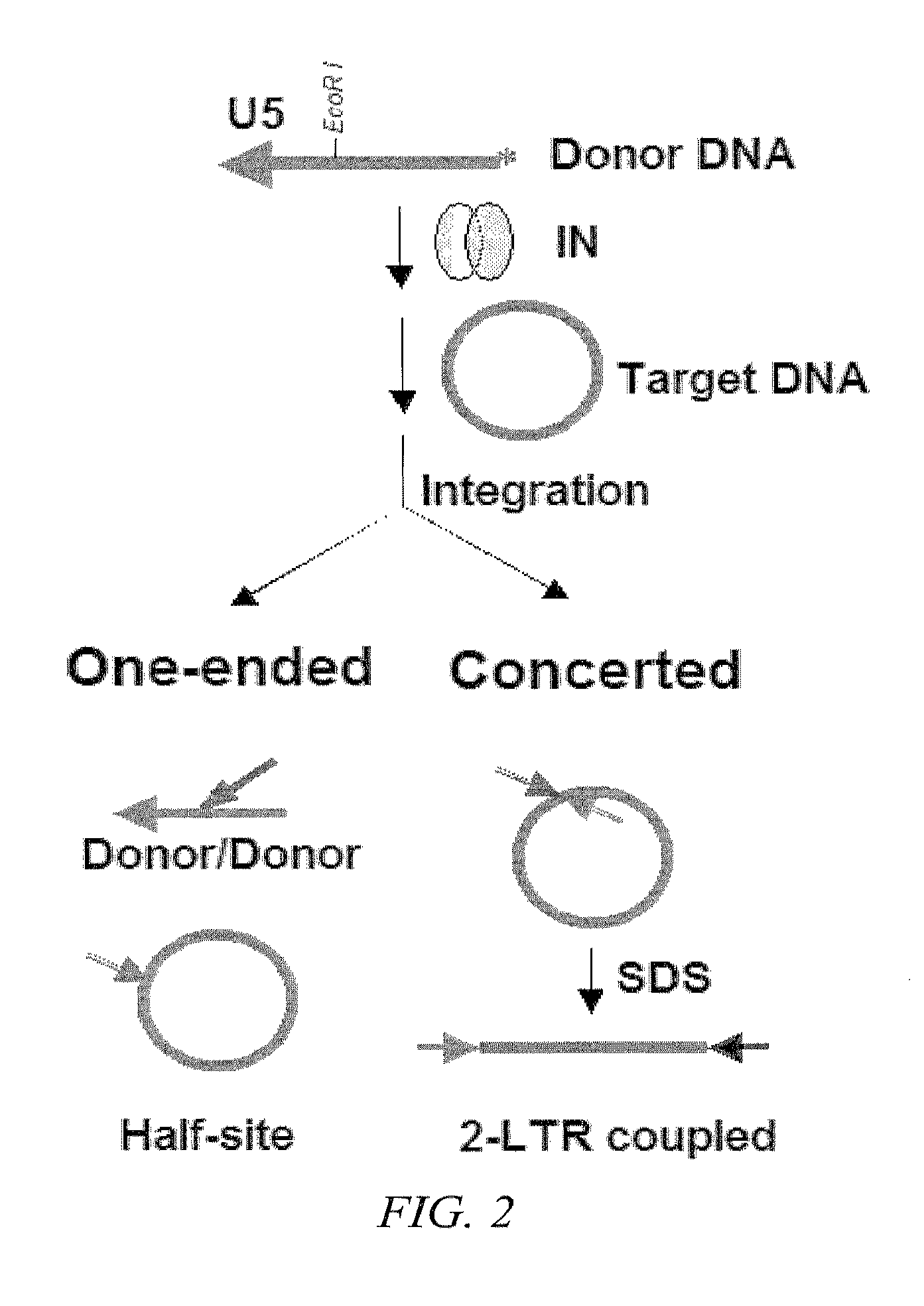Inhibitors of viral integrase and methods of use
a technology of viral integrase and inhibitors, which is applied in the direction of chemical treatment enzyme inactivation, drug compositions, peptides, etc., can solve the problems of high failure rate, inefficient treatment, and rather problematic study results
- Summary
- Abstract
- Description
- Claims
- Application Information
AI Technical Summary
Benefits of technology
Problems solved by technology
Method used
Image
Examples
example 1
Identification of Peptides that Interact with HIV IN
[0137]A yeast-based screening platform for identifying inhibitors of IN was constructed. In this platform, HIV IN was amplified from the pNL4-3 based provirus (R9) as template and cloned into two expression vectors resulting in a fusion of IN C-terminus to the GAL4 DNA binding domain (GALDB) and the GAL4 activation domain (GALAD) respectively. By western blot analysis, GALAD-IN was detected (not shown); however, GALDB-IN was barely detectable. Yeast harboring IN fused to the activation and binding domains activated the two-hybrid reporter, suggesting that sufficient amounts on IN were present to detect previously documented self-association. Other combinations of control vectors or HIV gag plus GALDB-IN or GALAD-IN failed to activate the reporter suggesting that viral integrase was not a self-activator.
[0138]To identify IN-binding peptides, yeast producing HIV integrase was mated with yeast harboring a random peptide library (15 am...
example 2
Confirmation of IN Inhibition
[0139]To confirm IN inhibition by SEQ ID NO:1, SEQ ID NO:2, and SEQ ID NO:3, a concerted integration assay test was used to measure the level of DNA integration by a construct mimicking a retrovirus.
[0140]Generally, IN catalyzes a transesterification reaction; the 3′ hydroxyl group of the viral DNA ends attack a pair of phosphodiester bonds in the target DNA. In a half-site integration reaction, viral integrase ligates one viral DNA end with one strand of the circular DNA target; in concerted integration two viral DNA ends are joined to a circular target resulting in linearization of the target DNA. FIG. 2 displays both the half-site and concerted integration of a circular target DNA. See Craigie, et al. J. Biol. Chem. (2005) 280(32):29334-9 and Craigie, et al. Retroviral DNA integration: reaction pathway and critical intermediates. EMBO J. (2006) 25(6):1295-304 and which are hereby incorporated by reference in their entirety for further details regardin...
example 3
Screening for Chemical Inhibitors of IN
[0144]Using the yeast two hybrid system described above along with the peptide-IN interaction, chemical libraries can be screened under high throughput conditions for compounds that disrupt peptide-HIV IN interactions in yeast. Chemicals that interfere with the interaction between peptide and target will be identified by their ability to reduce reporter transcription. High-diversity chemical libraries are utilized that contain compounds from natural libraries (i.e. isolated compounds from marine organisms) and compounds of substantial purity with known drug-like properties. These will be screened either individually or in small pools (<10 compounds / pool) at concentrations of 10-100 μM. As a negative control for each compound or pool screened, these yeast cells will be screened against yeast cells that express an unrelated complex whose formation activates the reporter.
[0145]To select the best candidates for screening, selective hits, i.e. those...
PUM
| Property | Measurement | Unit |
|---|---|---|
| volume | aaaaa | aaaaa |
| displacement | aaaaa | aaaaa |
| size | aaaaa | aaaaa |
Abstract
Description
Claims
Application Information
 Login to View More
Login to View More - R&D
- Intellectual Property
- Life Sciences
- Materials
- Tech Scout
- Unparalleled Data Quality
- Higher Quality Content
- 60% Fewer Hallucinations
Browse by: Latest US Patents, China's latest patents, Technical Efficacy Thesaurus, Application Domain, Technology Topic, Popular Technical Reports.
© 2025 PatSnap. All rights reserved.Legal|Privacy policy|Modern Slavery Act Transparency Statement|Sitemap|About US| Contact US: help@patsnap.com



